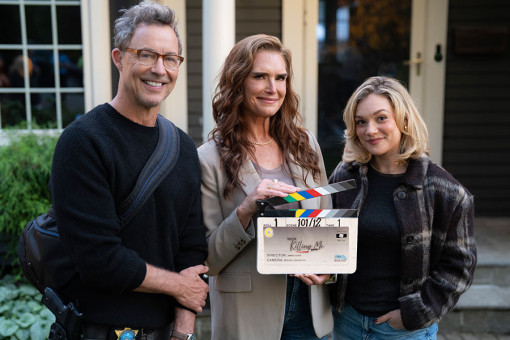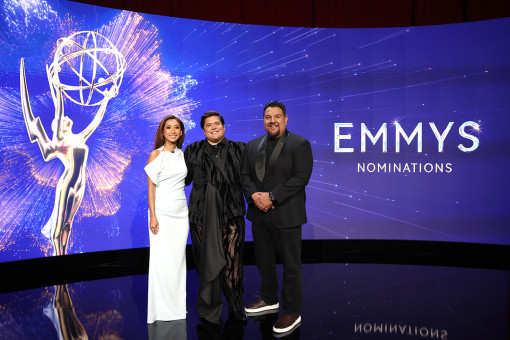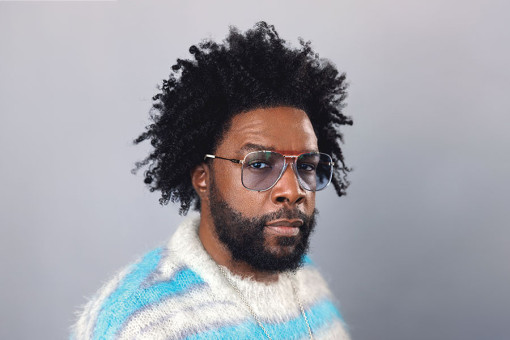For his new Hulu and Onyx Collective documentary Black Twitter: A People’s History, Prentice Penny turned toward two unlikely sources for inspiration: Star Wars and Harry Potter.
While adapting Wired senior writer Jason Parham’s three-part article series, “A People’s History of Black Twitter,” into an unconventional documentary that chronicles the birth and evolution of the titular social media phenomenon, the multihyphenate and former showrunner of HBO’s Insecure relied on the aforementioned movie franchises’ use of a three-act narrative structure to help shape all three parts of Black Twitter, which premieres May 9.
“It’s a coming-of-age story,” Penny tells the Television Academy in an exclusive interview. “As I kept talking to Jason about what [this documentary] was going to look like, we realized that Black Twitter, in the beginning, was young, fun and in its youth. So that was part one, act one, where the “hero” — in this case our subject matter — doesn’t know they are the hero yet. It’s just existing, having fun. Then, in the second episode [of Black Twitter], that’s when we meet our first moment of adversity, which is [the death] of Trayvon Martin. And in the third segment, it’s like we’re facing the big villain, like facing the Emperor or Voldermort. And in ours, as we were making it, [it was] Elon [Musk] buys the platform.”
Penny’s follow-up to Insecure examines more than a decade of political and cultural history through the Black Twitter lens in a way that vividly captures that era’s peaks and valleys similar to how a movie would. But, unlike a movie, Penny and his team devote significant narrative real estate to chronicling the real-life events that form the bedrock of both the Black Twitter phenomenon and the impact it had (and continues to have) on society. To celebrate the documentary’s release, Penny unpacks his creative process and reveals how the production team approached set design and on-screen graphics to capture the tone and feel of Black Twitter in real time.
This is your first documentary. How does your experience with scripted, fictional TV help you when approaching something in the non-scripted space like Black Twitter?
Prentice Penny: I think [working in] scripted helped me, being a comedy writer, [because] there's a lot of comedy, obviously, on Black Twitter. So for me, it was [a question of], visually, how do we infuse comedy into the doc? And how do we make it tonally feel like Black Twitter, like you’re experiencing Black Twitter? What's that style look like? I didn’t want it to just be a doc where someone's talking to the camera. It should feel the way you engage on Black Twitter. So, visually, for us, it was like: “Okay, we’ll start with someone's avatar, then we’ll pull out or zoom in [on it]. We'll be able to scroll through stuff. Somebody will talk in the frame, and we'll zoom in the way that we all engage on all social media — using GIFs and memes to punctuate certain points when we feel that is the right tone. And, this may seem like a small thing, but from a production design standpoint — as a scripted person — you're always thinking about, “What is the space that these people are in? What does [that set] look like?”
Speaking of, Black Twitter employs some outside-the-box sets for its interview subjects – like a beauty salon or a park bench with a fall-themed backdrop. How did you and your production team land on those set choices?
I wanted the sets to feel different and specific, and I wanted it to feel like spaces where people often engage with Black Twitter. So we have a beauty salon set, a barbershop set, a coffee house set, a park set. We have a subway set. And we try to tailor the set or the location to the person we are talking to, as well. For example, there was TJ [Adeshola], who worked at Twitter [as head of global content partnerships], so we had more of a tech set for him. The intention behind all this is: If we are visually giving you a style, and then we're giving these sets that have a style, when you're watching [Black Twitter] — maybe, even subconsciously, you're not even aware of it — but you're engaged in a totally different way, visually, to follow the story and engage with the story. More than, say, just the standard or usual living room set with someone talking to camera. It became “What’s our version of a park? What’s our version of this location look like?”
Also unique are the on-screen graphics and audio design to mirror a Twitter interface. Like asking interviewees the question “What is Black Twitter to you?” and then showing their answer on screen with a character count. How did you land on that?
It was a combo. I think we were always looking at it like, “How do we make this feel as organic as it can be and realistic as it can be?” And our graphics department was incredible in terms of suggesting things and pulling things out: “How about this, how about that?” And working in half-hour comedy, you’re not working with a ton of graphics. My career has not been defined by special effects and graphic effects. You know, not a lot of chyrons on [the ABC sitcom Penny wrote on] Happy Endings. But this part of the process was really fun because it was like, “how do you do this to help tell the story?” And for us, we were having very specific conversations — even debates. Like, “Well, should the Twitter font be the original Twitter font, from when the platform first launched?” “Should the Twitter page be green in the beginning, the way Twitter was?” Or, “As we move along, should the font grow and evolve?” And then to see an evolution — we were having super granular conversations about that. In essence, we went with doing what would be the easiest thing for the viewer to process.
How did your work in scripted television help you with decisions like that, and shaping the overall narrative of the documentary?
When I initially read the article, it gets tricky because you're like, “What's the narrative?” So working in scripted TV helped me focus on that. Black Twitter is this really amorphous thing. It's not like you're doing a doc on the March on Selma, where you're like, “Oh, it's an event with a clear timeline, or you're following a person.” So [something like] that gives you an arc. And as we thought about it, we would use or reference Star Wars or Harry Potter as a three-act structure.
As I kept talking to Jason about what [this documentary] was going to look like, we realized that Black Twitter, in the beginning, was young, fun and in its youth. So that was part one, act one, where the “hero” — in this case, our subject matter — they don’t know they are the hero yet. It’s just existing, having fun. Then, in the second episode [of Black Twitter], our second act in a way, that’s when we meet our first moment of adversity, which is [the death] of Trayvon Martin. And in the third segment, it’s like we’re facing the big villain, like facing the Emperor or Voldermort. And in ours, as we were making it, [it was] Elon [Musk] buys the platform. So while that was horrible for the platform, as a storytelling device, it was helpful for us. When the original article came out, it was 2021. The article ends on January 6. So, as we're making the doc, January 6 happens. That totally changes things. It doesn't change the coming-of-age story, but it obviously changed where we were going and what we were trying to get to. And again, obviously, you see all the changes that have happened as a result.
If you had a Blu-ray release for this, what deleted scenes would you include?
Something deleted stuff would be the “Kendall Jenner Pepsi ad/solve police brutality” segment. There's a shot of it [in Black Twitter] now, but there used to be a segment about it. It got cut because if it is not telling the whole narrative of the thing, we had to pull it — even if it's a cool segment. We had lost Paula Dean and put [her] back in. A lot of stuff about games, and GIFs and memes were cut.
And to call back to my previous question, how has working on an unscripted doc influenced or changed how you approach work in the scripted space?
It made me want to go more granular about things when working in half-hour comedy. I think in comedy, you don't necessarily dive in super specific about certain things. In comedy, you're always thinking about character and humor. You’re thinking about what’s the real emotional story. But you're not always thinking about your sets in a comedy. And in the doc, we have to dive into everything with this super micro view to decide which scenes are going to make it in? What part of this are we leaving out? It's a lot of work. But a part of that was so much fun, because you're getting so granular in a way that I don't think sitcoms and half-hours get.
This interview has been edited and condensed for clarity.
Black Twitter: A People’s History streams May 9 on Hulu.














